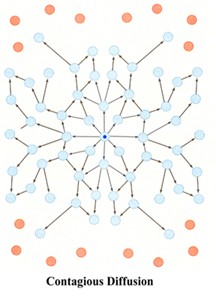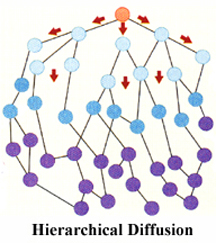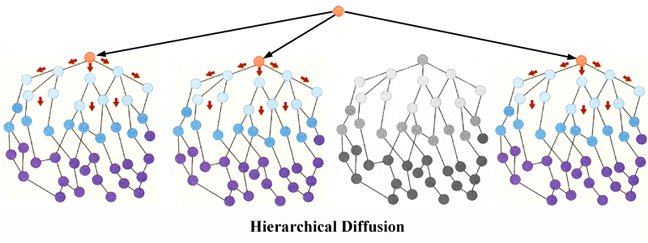Diffusion - structural characteristics - two types:
"In hierarchical diffusion, ideas leapfrog from one important
person to another, or from one urban center to another, temporarily bypassing
other persons or rural territory. . . By contrast, contagious diffusion
involves the wave-like spread of ideas, without regard to hierarchies, in
the manner of contagious disease." (Jordan, Domosh, & Rowntree
1994 The Human Mosaic p.16) |
 |
 |
contagious diffusion:
"Like the waves produced by dropping a rock into a pond of water,
the phenomenon spreads out through a uniform medium. Contagious diffusion
is based on proximity and contact. It is subject to distance decay as intensity
attenuates the further you get from the point of origin." (Alan Forsberg)
"The spread of cultural innovation through person to person contact,
moving wave-like through an area and population without regard to social
status."(Jordan, Domosh, & Rowntree 1994 The Human Mosaic p. G-4
)
"The distance-controlled spreading of idea, innovation, or some
other item through a local population by contact from person to person."
(DeBlij & Muller Geography: Realms Regions and Concepts 1994 John Wiley
& Sons)
At the local scale, a disease like cholera spreads contagiously. For
example:
hierarchical diffusion:
"When mapped out, hierarchical diffusion often produces a series
of non-contiguous spots which reflect the spatial expression of a structure
- social or physical. (Alan Forsberg, Lecture)
Examples:
In bioamplification / biomagnification, many toxins accumulate to the highest
concentration in the carnivores at the top of the foodchain.
HIV/AIDS is not very contagious. It only spreads through an exchange of
bodily fluids. It does not spread evenly, but most often kills the most
economically active portion of the population - people in their prime.
Today, people of color and the poor are more likely to suffer from environmental
injustice, and more likely to get HIV/AIDS than most Americans.
(Alan Forsberg)
"Innovations spread from one important person to another or from
one urban center to another, temporarily bypassing persons of lesser importance
and rural areas." (Jordan, Domosh, & Rowntree 1994 The Human Mosaic
p. G-8)
"An idea or innovation spreads by "trickling down" from
larger to smaller adoption units. An urban hierarchy is usually involved,
encouraging the leapfrogging of innovations over wide areas, with geographic
distance a less important influence."(DeBlij & Muller Geography:
Realms Regions and Concepts 1994 John Wiley & Sons)
"The process by which contacts between people and the resulting
diffusion of things or ideas occurs first among those at the same level
of a hierarchy and then among elements at a lower level of the hierarchy"
(Getis, Getis & Fellmann 1996 Introduction to Geography)
| Diffusion - dispersal characteristics - two
types:
The difference between expansion diffusion and relocation diffusion has
to do with what happens at the point of origin. In expansion diffusion,
what is being diffused remains at the point of origin, often becoming more
intense. With relocation diffusion, what is being diffused evacuates the
point of origin and moves on. |
 |
Alan's World




